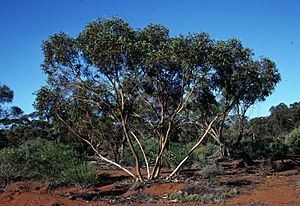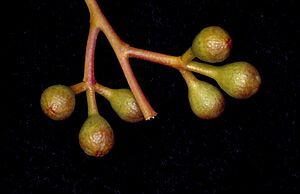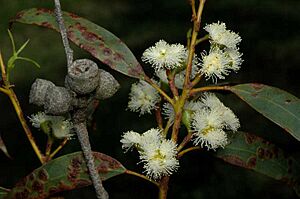Sandplain mallee facts for kids
Quick facts for kids Sandplain mallee |
|
|---|---|
 |
|
| Eucalyptus ebbanoensis near Kalgoorlie | |
| Scientific classification | |
| Genus: |
Eucalyptus
|
| Species: |
ebbanoensis
|
The Eucalyptus ebbanoensis, often called the sandplain mallee, is a special type of plant. It is a mallee, which means it usually grows as a shrub with many stems. This plant is found only in Western Australia. It has smooth, greyish bark. Its adult leaves are shaped like a spear or are slightly curved. The flowers are whitish and grow in groups of three. After flowering, it forms cup-shaped fruits.
Contents
What the Sandplain Mallee Looks Like
The Sandplain Mallee is a mallee that usually grows up to 6 meters tall. Sometimes, it can even become a small tree, reaching up to 10 meters high. This plant has a special woody base called a lignotuber. This helps it regrow if the top part is damaged, for example, by fire.
Young plants and new shoots have hairy stems. Their leaves have stalks and are about 45 to 80 millimeters long and 20 to 40 millimeters wide. Adult leaves are shaped like a spear or are slightly curved. They are 55 to 125 millimeters long and 7 to 22 millimeters wide. These leaves grow on a stalk that is 8 to 20 millimeters long.
The flower buds grow in groups of three where the leaves join the stem. Each group of buds is on a stalk about 4 to 10 millimeters long. The individual buds have smaller stalks, 1 to 5 millimeters long. When the buds are ready, they are oval or pear-shaped. They are 4 to 7 millimeters long and 5 to 7 millimeters wide. They have a cone-shaped or rounded cap.
Most of the flowering happens from September to December. The flowers are a creamy white color. After the flowers, the plant produces a woody fruit. This fruit is shaped like a cup, a half-sphere, or a bell. It is 6 to 11 millimeters long and 8 to 12 millimeters wide. The parts that open to release seeds are usually level with the rim of the fruit.
How it Got its Name
The Sandplain Mallee, Eucalyptus ebbanoensis, was first officially described in 1921. A scientist named Joseph Maiden described it. He used a plant sample collected by Alexander Morrison in 1904. This sample came from Ebano Springs, near Mingenew.
The name ebbanoensis comes from "Ebano Springs," where the first sample was found. The ending -ensis is a Latin word part. It means "from a place" or "belonging to a country."
Scientists have described three slightly different types, or subspecies, of Eucalyptus ebbanoensis:
- Eucalyptus ebbanoensis subsp. ebbanoensis: This type has dull leaves that are not shiny or powdery-looking.
- Eucalyptus ebbanoensis subsp. glauciramula: This type has leaves that look powdery or bluish-white.
- Eucalyptus ebbanoensis subsp. photina: This type has glossy, shiny leaves.
Where the Sandplain Mallee Grows
The Sandplain Mallee grows in different places in Western Australia. You can find it on sandy plains, on granite hills, and near rocky cliffs. It likes sandy soils and soils that come from a type of rock called laterite.
The most common type, ebbanoensis, is found across parts of the northern Wheatbelt and Goldfields-Esperance regions. It also grows to the western edge of the Great Victoria Desert.
The subspecies glauciramula grows to the east of these areas. The subspecies photina is found in a smaller area. It grows in the Moresby Range, north and east of Geraldton. These areas mostly get rain in winter, with about 250 to 400 millimeters of rain each year.
Is it Protected?
The Western Australian Government's Department of Parks and Wildlife checks on the Sandplain Mallee. They say that Eucalyptus ebbanoensis as a whole, and its subspecies ebbanoensis and glauciramula, are "not threatened." This means they are not currently at risk of disappearing.
However, the subspecies photina is classified as "Priority Four." This means it is rare or almost threatened. It needs to be watched carefully to make sure its numbers stay healthy.



